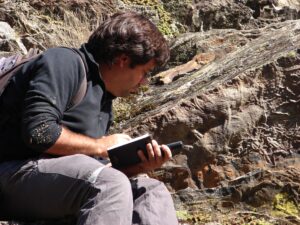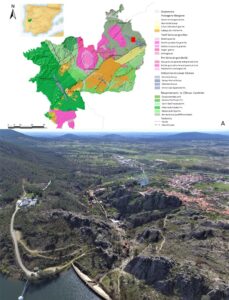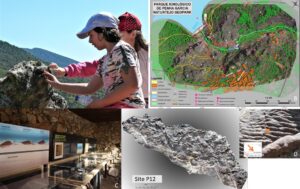Introduction
The Penha Garcia Ichnological Park: Ordovician Expressions of Good Taste
The Penha Garcia Ichnological Park located in central east Portugal (Beira Baixa), near the border with Spain, is a key reference geosites of outstanding international value in the Naturtejo UNESCO Global Geopark. The extremely abundant and well-preserved trace fossil record features the Armorican Quartzite facies across north-western Gondwana which are composed of deltaic and shallow marine deposits from the southern margin of the Rheic Ocean, developed during its transition to a drifting stage with the breakup of Gondwana (Bayet-Goll & Neto de Carvalho 2020). The protected section in the Ponsul river gorge covers an area of 1 km2 and its paleontological record dates from Lower to Middle Ordovician (Floian–Darriwilian). It was first studied in the 1850s (Neto de Carvalho 2010; Baucon et al. 2012), becoming a worldwide reference for understanding the intrastratal preservation and foraging ethology of the ichnogenus Cruziana, the archetypical form of the Cruziana Ichnofacies (Goldring 1985; Neto de Carvalho 2006; Seilacher 2007). Penha Garcia reveals an unusual abundance of these trace fossils, ranging over three orders of magnitude in both length and width, from 1 mm wide to a world record of 260 mm (Neto de Carvalho 2006; fig. 1).

Figure 1. Penha Garcia ichnology became known by the largest Cruziana trace fossils ever found and their outstanding abundance and preservation, an international reference for the study of these iconic trace fossils from the Paleozoic.
The Penha Garcia Formation was formally proposed by Bayet-Goll & Neto de Carvalho (2020) for the Armorican Quartzite in the southern part of the Central Iberian Zone. The complete sedimentary succession analyzed, bed by bed, in the stratotype defined at Penha Garcia Ichnological Park, is over 300 m thick. The Penha Garcia Formation overlies gradually the early Ordovician fan delta deposits of Serra da Gorda Formation and its top passes to the Brejo Fundeiro Formation with graptolites of the murchisoni Biozone found at the base and dated as middle Darriwilian (Neto de Carvalho 2006; Neto de Carvalho et al. 2014). Relying on the integration of sedimentary and ichnological characteristics, it was possible to define two main groups of facies associations, which are interpreted as deposited in a mixed river- and wave-influenced asymmetrical delta with a trend of along-strike variations between wave-dominated strand plain (updrift) and river-dominated deltaic settings (downdrift). The vertical stacking arrangements of parasequences and sedimentary geometries led to the identification of five depositional phases. Detailed analysis of the geometry and the stratigraphic architectural style of the depositional phases along the depositional strike, showed that the deposition of the Penha Garcia Formation likely took place by an increase in the rate of accommodation, following a first-order sea-level transgression and high subsidence rates, coupled with an increase in sediment supply, which could have been locally amplified by compaction of the prodelta-related pelitic beds.
The highest bioturbation intensities and ichnodiversity occur in two facies associations, namely storm-dominated distal/proximal prodelta and prodelta/distal mouth bar (distal delta front). So far, 21 ichnogenera and 36 ichnospecies have been identified at Penha Garcia. These ichnotaxa reflect a wide spectrum of behaviors, ascribed to trilobites, phyllocarid crustaceans and other endobenthic arthropods, early nuculoid bivalves, actiniarian sea anemones, as well as sessile suspension polychaetes or phoronids, and feeding and vagile deposit feeding worms (Neto de Carvalho et al. 2014). Body fossils comprise rare obolid brachiopods and a single asaphid trilobite.

Figure 2. A) The geological map of Naturtejo UNESCO Global Geopark with the location of Penha Garcia Ichnological Park. B) Aerial view of the Park located in the 140 m-deep Ponsul river gorge just at the backskirts of Penha Garcia.
Trace fossils and particularly Cruziana are common biogenic sedimentary structures in the Armorican Quartzite facies worldwide. They are included in important fossil sites, particularly in UNESCO Geoparks located in the Central Iberian Zone. Several aspects make Penha Garcia a reference site of ichnological international importance (see Neto de Carvalho et al. 2014; Neto de Carvalho 2006; Neto de Carvalho and Baucon 2016): (1) the abundance of trace fossils of the Cruziana rugosa group, represented by thousands of trace fossils disrupting over 100 bedding planes, and the development of Cruziana “highways” ( et al. 2020; fig. 3), (2) the diversity of behaviors reflected in the ichnological record, representing not only feeding burrows and foraging strategies but also locomotory styles and domiciliary structures, (3) the exceptional preservation and exposure of the trace fossil record, in a small and rather accessible area, (4) the variety of trace sizes, ranging from 1 to 260 mm in width, the (probably) smallest but also the largest Cruziana ever found, and (5) the very rare documentation of a Cruziana and its producer (asaphid trilobite), both occurring in the Penha Garcia Formation in the same unit (Neto de Carvalho 2006; Seilacher 2007; Neto de Carvalho & Baucon 2016).
Finally, the remarkably large size of the Cruziana specimens in Penha Garcia, and therefore of their producers, maybe the result of the phyletic trend for gigantism that had a peak worldwide during the Darriwilian stage, about 465 Ma (Bell & Braddy 2012), and related to the gradual onset of the Global Ordovician Biodiversification Event (GOBE), a major evolutionary radiation of animal life, in high paleolatitudes. GOBE comprises the massive adaptive diversification of marine organisms during the late Cambrian-Middle Ordovician, that has been related to a major increase in atmospheric O2, increased ocean nutrient availability, significant diversification of different groups of plankton, and the switch to a pelagic mode of life in several groups (see Servais et al. 2016). In Penha Garcia, the giant trilobites producing Cruziana rugosa were well adapted to greenhouse warm high paleolatitude waters, but especially to high salinity fluctuations, high nutrient runoff and therefore extensive food resources (pelagic rain of dead organic matter accumulated in the substrate) with frequent oxygen depletion, as well as possibly low predation pressures in the deltaic-influenced, storm-deposited substrates (Neto de Carvalho 2010; Neto de Carvalho & Baucon 2016). They occur together with microbially-induced sedimentary structures, at high bioturbation indices followed by non-bioturbated beds or typically Cambrian Skolithos piperock ichnofabrics, and integrating relatively shallow tiering bioturbation, which are all examples reminiscent of the Early Cambrian style of substrate colonization. Despite this remarkable evidence, some of the earliest evidence of nuculoid bivalve behavior can be found at Penha Garcia, which represents the early escalation of the typical Paleozoic fauna that dominated progressively all sea bottoms during and after the GOBE.

Figure 3. A) Cruziana burrows are among the most abundant trace fossils in Penha Garcia Ichnological Park, covering large bedding planes with their scribbling foraging patterns, and attracting the curiosity of the visitors (A). B) 3D model of part of the exposed bedding surface showing a dense trilobite foraging area with the typical bilobate burrow patterns, with a visible part of the bed below apparently unbioturbated.
The Fossil Trail: a Reference for Geotourism in Portugal
Since 2003 Penha Garcia has become a reference destination for nature tourism in the centre of Portugal. Together with Monsanto and Idanha-a-Velha historical villages, which were included in a development rural program called the Historical Villages of Portugal, and with Termas de Monfortinho famous hot springs village and another geosites nearby, Penha Garcia Ichnological Park is located on the main tourist route of Idanha-a-Nova and one of the most important in the whole borderland with Spain. The Fossil Trail was one of the early pedestrian trails to be developed in the region (Neto de Carvalho 2004; Rodrigues & Neto de Carvalho 2009). This 3 km circular trail connects the historical center of Penha Garcia village with the Ponsul river gorge where the Ichnological Park is located. Other attractions along the trail (Fig. 4B), such as the Knights Templar Castle and the Mother Church viewpoints, the picturesque quartzite popular architecture, the pillory as a symbol of the former municipal autonomy, the contrasting landscapes of high quartzite cliffs formed as a result of Variscan tectonics, and the silent lake in the axis of the syncline, the climbing ways, the restored watermills where the Fossil Home is located (Fig. 4C), the Pego river pool crowded in summer, and the riverside native flora, makes the Fossil Trail an attraction for the whole family.
Every year, 14000 visitors sign the honor book in the Fossil Home, positioned halfway along the Fossil Trail. People from over 30 nationalities already voted that the Fossil Trail is one of the most beautiful trekking routes on the mainland of Portugal, and frequently reported in national and international traveling magazines, websites, and blogs. One of the world’s leading travel websites nominated Penha Garcia as the Traveller’s Choice 2020 for the category Nature and Wildlife Areas in Portugal. The trekkers come and stay overnight mostly because of the “fossils” and the dramatic geological landscape that greatly impacts the visitor (Geotourists sensu, Farsani et al. 2011). Other long trails cross Penha Garcia, such as the Historical Villages Long Trail and the GR12 E7, a trans-European path that connects the Romanian city of Constanza with Lisbon. Penha Garcia will soon be crossed by connection to the International Appalachian Trail with Spain. Also, it will be integrated into the tourist Armorican Quartzite Route, a transborder INTERREG project with the Province of Cáceres in Spain, planning to connect Villuercas-Ibores-Jara and Naturtejo UNESCO Geoparks. A new highway passing a few kilometers from Penha Garcia will improve the connection between Lisbon and Madrid. Quality lodging and other business, such as the Manuel Teixeira Stud Farm “Geocoudelaria”, are growing in Penha Garcia with the potential of this Geotourism destination (Neto de Carvalho 2005, 2009; Neto de Carvalho et al. 2009).
Penha Garcia Ichnological Park has been the main stage for several scientific meetings and congress field excursions, including the 4th International Congress of Ichnology that was held in Portugal in 2016 (Baucon and Neto de Carvalho 2017). It is regularly included in research projects, topics of academic theses and fields for training university students in different geoscientific disciplines, from paleontology to environmental geology and geoconservation. As a comprehensive nature school, where good access and proximity to geodiversity and biodiversity allow direct contact with clear examples from the educational national curriculum, it is the most visited geosite in the Naturtejo Geopark for local schools and schools coming from all over the country and abroad, from kindergarten to high school (Catana 2009, 2010; Rodrigues et al., 2013; fig. 4A). The trace fossils from Penha Garcia are commonly presented in natural sciences and geology textbooks, as well as in national exams.
The “Painted Snakes”: Protecting and Valorizing a Symbol of Penha Garcia’s Community
The Cruziana trace fossils of Penha Garcia represent a multifaceted heritage that not only covers scientific aspects, but also humanistic ones. In fact, the abundant Cruziana trace fossils are part of the local community's cultural heritage described as Painted Snakes and included in legends (Neto de Carvalho & Cachão 2005; Neto de Carvalho et al. 2008). They are ichnohierophanies as defined by Baucon et al. (2008), protected as cultural heritage at a local level by municipal decision. The ancient perception of the existence of such fossils attracted pioneering work about their paleontological origin and significance (Baucon 2009a; Baucon et al. 2012). The fossil burrows of Penha Garcia have been presented as artworks in the influential exhibition ‘Fossil Art,’ organized by the eminent paleontologist Adolf Seilacher (Seilacher 2005, Neto de Carvalho et al. 2014) . It should also be highlighted that ichnofossils are found on the building stones of several historical buildings in Penha Garcia. Once unacknowledged, ichnofossil-bearing building stones have recently been recognized as an important geoheritage feature, with major scientific significance and cultural value (Francischini et al. 2015; Martínez-Graña et al. 2016; Baucon et al. 2020) .
The aforementioned examples show that the trace fossils of Penha Garcia represent a unique paleontological, ethnographic, folkloric and artistic heritage, thus requiring special measures of protection and valorization. In this regard, the landmark event was the establishment of the Naturtejo UNESCO Global Geopark in 2003, which marked its international relevance (Neto de Carvalho & Rodrigues 2015). The park is permanently under observation by a dedicated ranger.
Innovative multimedia tools have been applied for the valorization of the Penha Garcia ichnosite. The international exhibition ‘From Trilobites to Man’ brought the Penha Garcia heritage to the Natural History Museum of Lesvos (Greece) by the application of computer-vision and augmented reality (Baucon & Neto de Carvalho 2008; Neto de Carvalho et al. 2014). A mobile phone game about the Diplocraterion burrows of Penha Garcia was released in the same period (Baucon & Neto de Carvalho 2008). The innovative character of these valorization initiatives is underlined by comparing their development with the iPhone timeline, i.e., the development of the Penha Garcia interactive tools started before the release of the first iPhone in 2007. Movies have also been an integral part of the promotion of the Penha Garcia site, and it has been discussed in several documentaries (‘Travel in the world of trilobites’ produced by Beira TV; ‘Geopark Naturtejo: an oasis in Europe’ directed by Jorge Fialho in 2006; ‘Course in Time’ directed by Carine Pires in 2007). This visual communication strategy involved the popularization of the Penha Garcia geosite from an educational context. For example, video art and sculptures regarding Penha Garcia have been specifically developed for the Boom Festival, one of the major electronic music festivals in Iberia (Baucon, 2009b).
Later, the Penha Garcia Ichnological Park was included in the list of geosites of national relevance (Neto de Carvalho 2012) and it is a significant example of ichnological heritage from this country (Rodrigues et al. 2016). It is also one of the few examples of protected, equipped and interpreted Ordovician paleontological sites in Portugal (Couto et al. 2012).
Recently, a project was developed by the municipality of Idanha-a-Nova to survey potential damage of paleontological heritage by erosion and vandalism. The whole Ponsul gorge was covered by digital aerophotogrammetry and 15 main fossil sites by short-distance photogrammetry. This method allows 2D images to be converted into 3D point clouds sustained by complex and robust mathematical algorithms. These point clouds are composed of several million points, used to process the texturized mesh models. Aerophotogrammetry by drone enabled researchers to obtain georeferenced orthophotos with a few cm of error, excellent for photointerpretation and 2D mapping, as well as texturized 3D models. Short-distance photogrammetry presents a high-resolution zooming capacity and the possibility of 3D modeling and analysis, with sub-millimetric resolution (Fig. 4D). This survey can be repeated regularly and will quantitative measurement of the weathering of exposed bedding planes by biological activity and physical agents (rain, gravity) and this data will be decisive, not only to showcase virtual 3D images and printings of trace fossils in the projected interpretation center, but also for planning how to expose and exhibit large bioturbated bedding planes to improve the attractiveness of this unique ichnological park.

Figure 4. A) Penha Garcia Ichnology Park is one of the most popular outdoor nature schools in Portugal and the most popular educational program in Naturtejo Geopark .B) Park’s official Fossils Trail and other trails location to access to the main sites of interest, including ichnofossil sites . C) The Fossils Home is located in the heart of the Park and showcases the interpretation of Cruziana trace fossils as trilobite behaviors, with the first-contact exhibition of local trace fossils and body fossils, rocks and minerals . D) Digital orthophotos of high resolution made for scientific and geoconservation purposes. The resolution obtained enables to analyze morphological and weathering features at the scale of the cliffs where the bedding planes with the best trace fossil records are exposed to the erosional elements, up to the mm-scale leg bioimprints preserved in Cruziana .
Summary: Memories of a Sea without Fish
A nature school or a “fossil art” gallery: both perspectives fit in the Penha Garcia Ichnological Park. Trace fossils can be appreciated by everyone as “fossil art” left on the seabed during the climax of trilobite evolution, in an ocean without fish, or at least absent here. This is the right context to raise awareness about geodynamics, climate change or even extinctions and the evolutionary processes of life, for different school levels or the layperson. This small gorge provides an excellent diversity of landforms, with so many small stories to tell, and the strange ‘painted snakes’ raise the curiosity of visitors. For these reasons, it is essential to build a new interpretative center, to develop innovative interpretation tools, including new interactive approaches to access geodiversity and new large exposures with selected examples of trace fossil-rich bedding planes. Science operating in continuum brings new layers to the already rich menu of stories told in Penha Garcia.
Maybe the beauty of the scribbled shapes from deep time, created by primeval invertebrates going about their daily business, create something fundamental in our aesthetic sense, an appreciation of the functional geometries of Nature. At least for the people of Penha Garcia these Cruziana specimens were admired centuries ago, and given alternative explanations as the so-called ‘painted snakes.’ For those who are fascinated by the origin of natural phenomena, we could not be in a better place.
Acknowledgments
We deeply thank the people that have been working together in the Penha Garcia Ichnological Park over the years to protect, conserve, clean and build one of the most iconic ichnological sites: the authorities of the Municipality of Idanha-a-Nova and the village of Penha Garcia, especially the Mayor Armindo Jacinto, the keeper Mr Domingos Costa, the technical staff of the Municipal Tourism Office, those responsible for the educational programs of the Geopark, Manuela Catana, the tour and educational guides and colleagues of many tours, school, and congress trips, Jorge Costa, Joana Rodrigues, the late João Geraldes, Rita Ferreira. Finally, Mário Piçarra and the Antunes family, local visionary entrepreneurs who fostered the tourism potential of Penha Garcia since its early days.
Conflict of Interest
The authors have no known conflict of interest.
